
Tatreez, the intricate, vibrant embroidery of Palestine, is more than just a decorative craft — for members of the community, it’s an art form that embodies history, identity and resistance.
Students for Justice in Palestine Carleton, Carleton University’s Muslim Students’ Association and the Palestinian Students’ Association at Carleton partnered to host the “Threads of Resilience Workshop” on Oct. 10, which taught tatreez to raise funds for Gaza.
The event raised money for Human Concern International, an organization that provides supplies and medical aid to displaced Palestinian families.
Tatreez is a centuries-old artistic practice passed down through generations which represents the story of Palestine.
Yasmen Abuzaid, a Palestinian activist, history teacher and workshop host, said tatreez is not static as an art form — it evolves and adapts with Palestinians as their stories shift with time. She has been practising tatreez since November 2023.
“I’m a history teacher, and I think of tatreez as a history textbook but written in thread,” she said. “Tatreez is an ever-evolving practice and tradition. There are going to be new motifs about this genocide [like] the red triangle and press signs have become symbols over the past year.”
Abuzaid said tatreez is passed down by mothers and daughters and is deeply rooted in the daily lives of Palestinian women.
“Traditionally, you could look at a girl or woman’s dress and know her social status, where she was from and her marital status,” Abuzaid said. “This is because the motifs, which are based off of nature and everyday objects, varied from area to area.”
Abuzaid said new motifs, like the rocket, appear in embroidery patterns to tell new aspects of Palestinian life. She said that during Israel’s first ban of the Palestinian flag following the Six-Day War in 1967, women created intifada, meaning “shaking off” or “civil uprising,” dresses that were covered in cross-stitched flags as a form of defiance.
To Abuzaid, what makes tatreez unique is the motifs.

Common motifs like the cypress tree symbolize resilience, life and longevity, while birds, stars and flowers often represent freedom, hope and beauty.
These patterns are embroidered using bright colours, typically red, green, black and blue. The materials used for tatreez include cloth, a tapestry needle, patterns and embroidery floss.
As a workshop attendee, Ilham Rahimi said she faced challenges with the intricacy of the artwork as a first-time learner.
“The embroidery is very tight and detailed so it can get quite tedious,” Rahimi said. “It’s good to take breaks, be patient and pay attention to details if you are following an instructor.”
Rahimi said she was able to explore the significance and impact of tatreez through the workshop.
“I’ve learned that its significance goes beyond art,” she said. “I found it interesting how it is used as an expression of Palestinian identity and heritage, but most importantly as a form of resistance.”
The preservation of this art form isn’t merely an act of artistic expression, but also one of survival. The ongoing conflict has threatened its cultural heritage, said workshop co-ordinator Dina Younes.
“Tatreez was created as a way of documenting important events and occasions on the clothing women wore,” Younes said.
As tatreez gains recognition globally, it continues to evolve, proving its resilience as an art form.
“There are also thousands of Palestinian women like me picking it up for the first time in their lives, and passing that onwards to others,” Abuzaid said. “So many non-Palestinians are picking it up, which is new historically. We’re shaping how tatreez looks in the present moment, which is so cool.”
Though young Palestinians are learning the craft as a way to reconnect with their roots, this workshop also allowed other people to learn about the craft. Abuzaid said the challenge now lies in maintaining the balance between preserving its traditional aspects and embracing modern interpretations.
“For non-Palestinians: what are you doing for us? It is not just enough to learn about our culture or to repost a social media graphic,” Abuzaid said. “How are you actively resisting and showing up for the people who created the art form you’re learning? If you aren’t, then you do not embody the real spirit of tatreez.”
Featured image by Salma Ibrahim.





